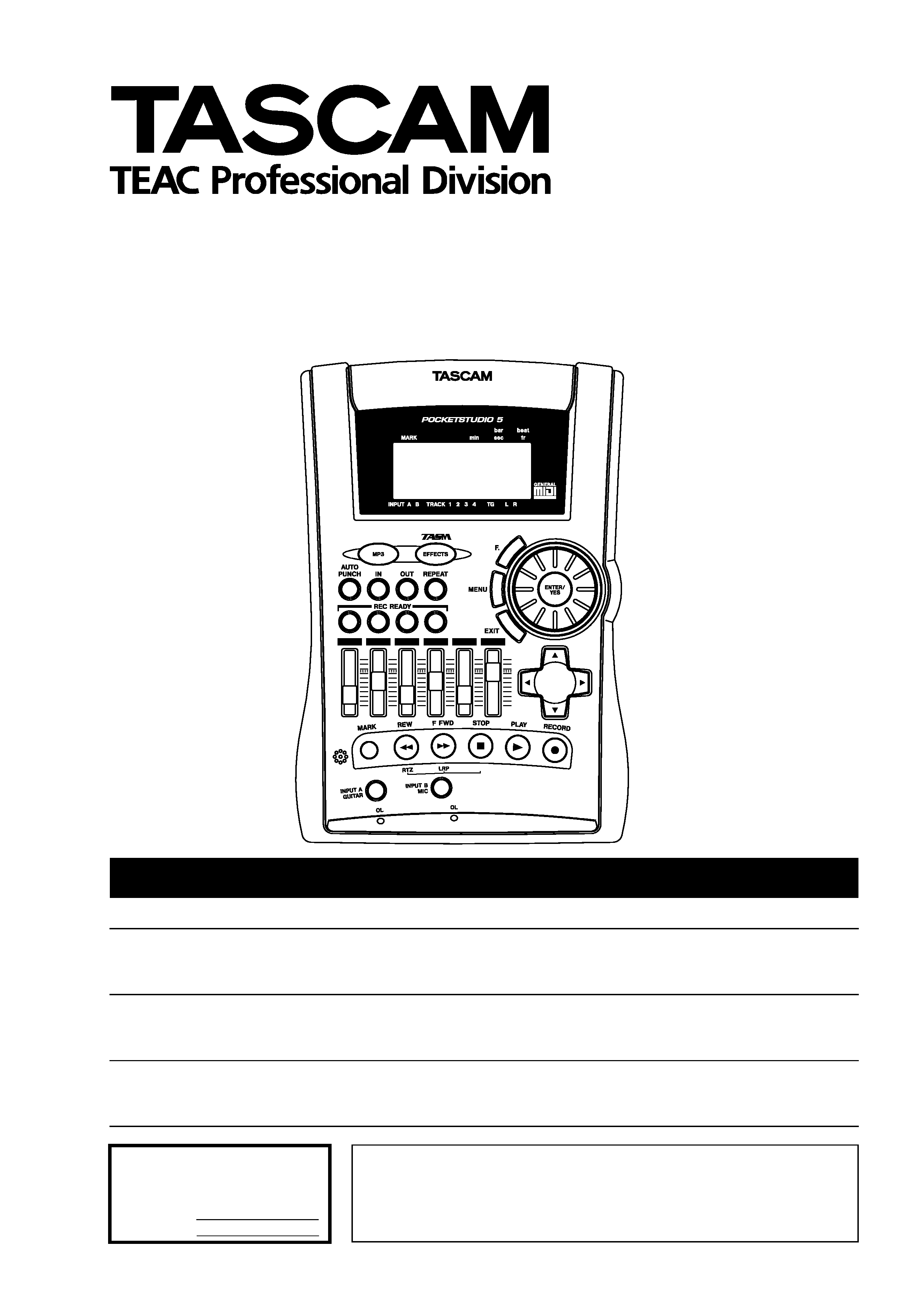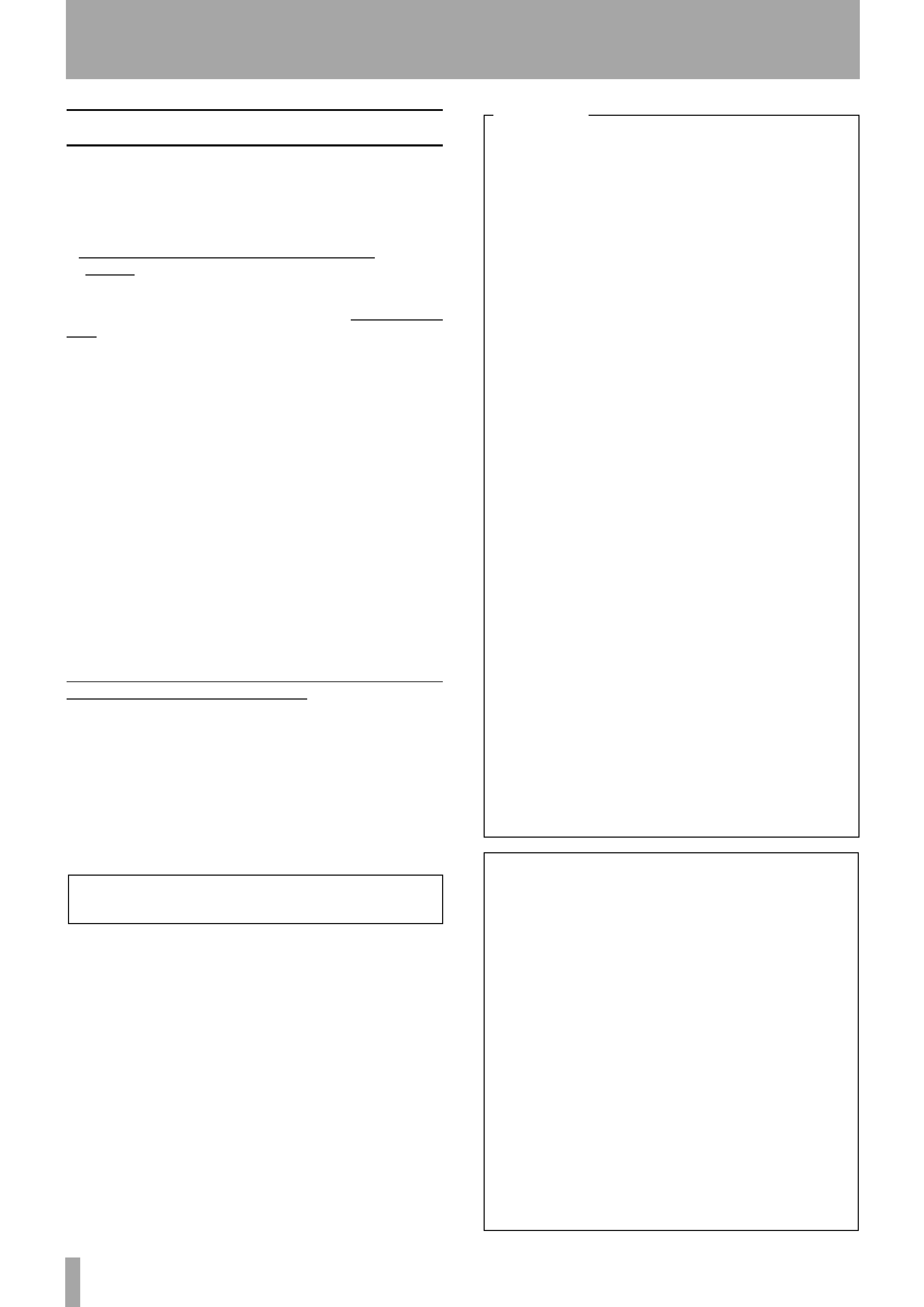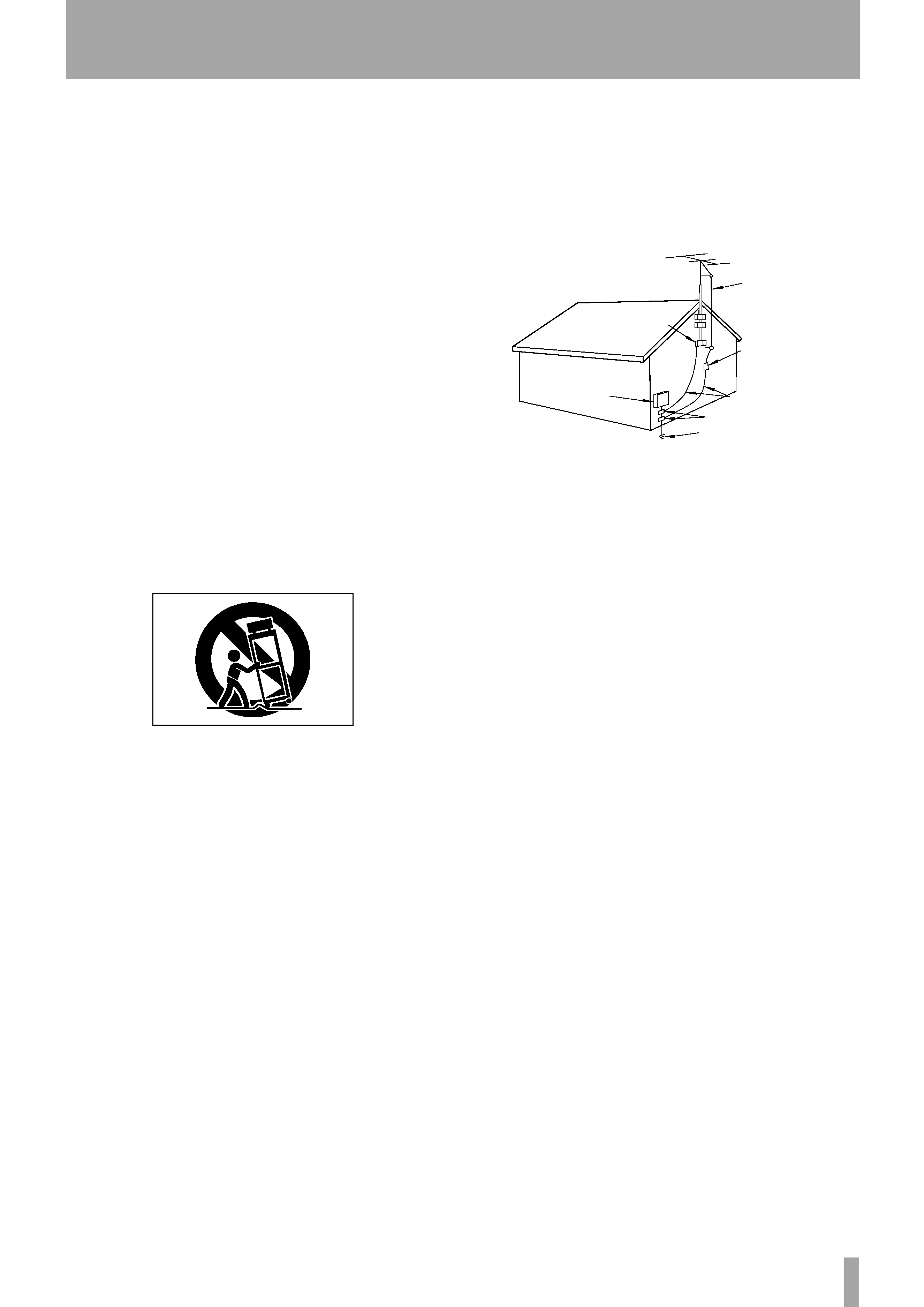
POCKETSTUDIO 5
4-Track Recorder/MIDI Arranger/MP3 Encoder
REFERENCE MANUAL
CAUTION: TO REDUCE THE RISK OF ELECTRIC SHOCK, DO NOT
REMOVE COVER (OR BACK). NO USER-SERVICEABLE PARTS
INSIDE. REFER SERVICING TO QUALIFIED SERVICE PERSONNEL.
The exclamation point within an equilateral triangle is intended to alert the user to the pres-
ence of important operating and maintenance (servicing) instructions in the literature
accompanying the appliance.
The lightning flash with arrowhead symbol, within an equilateral triangle, is intended to alert
the user to the presence of uninsulated "dangerous voltage" within the product's enclosure
that may be of sufficient magnitude to constitute a risk of electric shock to persons.
This appliance has a serial number
located on the rear panel. Please record
the model number and serial number
and retain them for your records.
Model number
Serial number
Ü
ÿ
Y
WARNING: TO PREVENT FIRE OR SHOCK
HAZARD, DO NOT EXPOSE THIS
APPLIANCE TO RAIN OR MOISTURE.

2 TASCAM Pocketstudio 5 Getting Started
Important Safety Precautions
IMPORTANT (for U.K. Customers)
DO NOT cut off the mains plug from this equipment.
If the plug fitted is not suitable for the power points in your home or
the cable is too short to reach a power point, then obtain an
appropriate safety approved extension lead or consult your dealer.
If nonetheless the mains plug is cut off, remove the fuse and dispose
of the plug immediately, to avoid a possible shock hazard by
inadvertent connection to the mains supply.
If this product is not provided with a mains plug, or one has to be
fitted, then follow the instructions given below:
IMPORTANT: DO NOT make any connection to the larger
terminal which is marked by the letter E or by the safety earth
symbol ç or coloured GREEN or GREEN-and-YELLOW.
The wires in this mains lead are coloured in accordance with the
following code:
BLUE
: NEUTRAL
BROWN
: LIVE
As the colours of the wires in the mains lead of this apparatus may
not correspond with the coloured markings identifying the terminals
in your plug proceed as follows:
The wire which is coloured BLUE must be connected to the terminal
which is marked with the letter N or coloured BLACK.
The wire which is coloured BROWN must be connected to the
terminal which is marked with the letter L or coloured RED.
When replacing the fuse only a correctly rated approved type should
be used and be sure to re-fit the fuse cover.
IF IN DOUBT -- CONSULT A COMPETENT ELECTRICIAN.
TO THE USER
This equipment has been tested and found to
comply with the limits for a Class B digital device,
pursuant to Part 15 of the FCC Rules. These
limits are designed to provide reasonable
protection against harmful interference in a
residential installation. This equipment gen-
erates, uses, and can radiate radio frequency
ene rgy a nd, if not installe d a nd used in
accordance with the instruction manual, may
cause harmful interference to radio comm-
unications. However, there is no guarantee that
interference will not occur in a particular
installation. If this equipment does cause harmful
interference to radio or television reception,
which can be determined by turning th e
equipment off and on, the user is encouraged to
try to correct the interference by one or more of
the following measures.
a)Reorient or relocate the receiving antenna.
b)Increase the separation between the
equipment and receiver.
c)Connect the equipment into an outlet on a
circuit different from that to which the
receiver is connected.
d)Consult the dealer or an experienced radio/
TV technician for help.
CAUTION
Changes or modifications to this equipment not
expressly approved by TEAC CORPORATION
for compliance could void the user's authority to
operate this equipment.
For the consumers in Europe
WARNING
This is a Class A product. In a domestic environment, this
product may cause radio interference in which case the user
may be required to take adequate measures.
Pour les utilisateurs en Europe
AVERTISSEMENT
Il s'agit d'un produit de Classe A. Dans un environnement
domestique, cet appareil peut provoquer des interférences
radio, dans ce cas l'utilisateur peut être amené à prendre
des mesures appropriées.
Für Kunden in Europa
Warnung
Dies is eine Einrichtung, welche die Funk-Entstörung nach
Klasse A besitzt. Diese Einrichtung kann im Wohnbereich
Funkstörungen versursachen ; in diesem Fall kann vom
Betrieber verlang werden, angemessene Maßnahmen
durchzuführen und dafür aufzukommen.
For U.S.A
The equipment draws nominal non-operating power from the
AC outlet with its POWER switch in the off position.

TASCAM Pocketstudio 5 Getting Started
3
CAUTION:
... Read all of these Instructions.
... Save these Instructions for later use.
... Follow all Warnings and Instructions marked on the audio
equipment.
1) Read Instructions -- All the safety and operating instructions should
be read before the product is operated.
2) Retain Instructions -- The safety and operating instructions should
be retained for future reference.
3) Heed Warnings -- All warnings on the product and in the operating
instructions should be adhered to.
4) Follow Instructions -- All operating and use instructions should be
followed.
5) Cleaning -- Unplug this product from the wall outlet before cleaning.
Do not use liquid cleaners or aerosol cleaners. Use a damp cloth for clean-
ing.
6) Attachments -- Do not use attachments not recommended by the
product manufacturer as they may cause hazards.
7) Water and Moisture -- Do not use this product near water -- for
example, near a bath tub, wash bowl, kitchen sink, or laundry tub; in a wet
basement; or near a swimming pool; and the like.
8) Accessories -- Do not place this product on an unstable cart, stand,
tripod, bracket, or table. The product may fall, causing serious injury to a
child or adult, and serious damage to the product. Use only with a cart,
stand, tripod, bracket, or table recommended by the manufacturer, or sold
with the product. Any mounting of the product should follow the manufac-
turer's instructions, and should use a mounting accessory recommended by
the manufacturer.
9) A product and cart combination should be moved with care. Quick stops,
excessive force, and uneven surfaces may cause the product and cart com-
bination to overturn.
10) Ventilation -- Slots and openings in the cabinet are provided for ven-
tilation and to ensure reliable operation of the product and to protect it
from overheating, and these openings must not be blocked or covered. The
openings should never be blocked by placing the product on a bed, sofa,
rug, or other similar surface. This product should not be placed in a built-in
installation such as a bookcase or rack unless proper ventilation is provided
or the manufacturer's instructions have been adhered to.
11) Power Sources -- This product should be operated only from the
type of power source indicated on the marking label. If you are not sure of
the type of power supply to your home, consult your product dealer or local
power company. For products intended to operate from battery power, or
other sources, refer to the operating instructions.
12) Grounding or Polarization -- This product may be equipped with a
polarized alternating-current line plug (a plug having one blade wider than
the other). This plug will fit into the power outlet only one way. This is a
safety feature. If you are unable to insert the plug fully into the outlet, try
reversing the plug. If the plug should still fail to fit, contact your electrician
to replace your obsolete outlet. Do not defeat the safety purpose of the
polarized plug.
13) Power-Cord Protection -- Power-supply cords should be routed so
that they are not likely to be walked on or pinched by items placed upon or
against them, paying particular attention to cords at plugs, convenience
receptacles, and the point where they exit from the product.
14) Outdoor Antenna Grounding -- If an outside antenna or cable
system is connected to the product, be sure the antenna or cable system is
grounded so as to provide some protection against voltage surges and built-
up static charges. Article 810 of the National Electrical Code, ANSI/NFPA
70, provides information with regard to proper grounding of the mast and
supporting structure, grounding of the lead-in wire to an antenna discharge
unit, size of grounding conductors, location of antenna-discharge unit, con-
nection to grounding electrodes, and requirements for the grounding elec-
trode.
"Note to CATV system installer:
This reminder is provided to call the CATV system installer's attention to
Section 820-40 of the NEC which provides guidelines for proper grounding
and, in particular, specifies that the cable ground shall be connected to the
grounding system of the building, as close to the point of cable entry as
practical.
15) Lightning -- For added protection for this product during a lightning
storm, or when it is left unattended and unused for long periods of time,
unplug it from the wall outlet and disconnect the antenna or cable system.
This will prevent damage to the product due to lightning and power-line
surges.
16) Power Lines -- An outside antenna system should not be located in
the vicinity of overhead power lines or other electric light or power circuits,
or where it can fall into such power lines or circuits. When installing an
outside antenna system, extreme care should be taken to keep from touch-
ing such power lines or circuits as contact with them might be fatal.
17) Overloading -- Do not overload wall outlets, extension cords, or
integral convenience receptacles as this can result in risk of fire or electric
shock.
18) Object and Liquid Entry -- Never push objects of any kind into
this product through openings as they may touch dangerous voltage points
or short-out parts that could result in a fire or electric shock. Never spill
liquid of any kind on the product.
19) Servicing -- Do not attempt to service this product yourself as open-
ing or removing covers may expose you to dangerous voltage or other
hazards. Refer all servicing to qualified service personnel.
20) Damage Requiring Service -- Unplug this product from the wall
outlet and refer servicing to qualified service personnel under the following
conditions:
a) when the power-supply cord or plug is damaged.
b) if liquid has been spilled, or objects have fallen into the product.
c) if the product has been exposed to rain or water.
d) if the product does not operate normally by following the operating
instructions. Adjust only those controls that are covered by the operating
instructions as an improper adjustment of other controls may result in
damage and will often require extensive work by a qualified technician to
restore the product to its normal operation.
e) if the product has been dropped or damaged in any way.
f ) when the product exhibits a distinct change in performance this
indicates a need for service.
21) Replacement Parts -- When replacement parts are required, be
sure the service technician has used replacement parts specified by the
manufacturer or have the same characteristics as the original part.
Unauthorized substitutions may result in fire, electric shock, or other
hazards.
22) Safety Check -- Upon completion of any service or repairs to this
product, ask the service technician to perform safety checks to determine
that the product is in proper operating condition.
23) Wall or Ceiling Mounting -- The product should be mounted to a
wall or ceiling only as recommended by the manufacturer.
24) Heat -- The product should be situated away from heat sources such
as radiators, heat registers, stoves, or other products (including amplifiers)
that produce heat.
ANTENNA
LEAD IN
WIRE
ANTENNA
DISCHARGE UNIT
(NEC SECTION 810-20)
G
ROUNDING CONDUCTORS
(NEC SECTION 810-21)
GROUND CLAMPS
POWER SERVICE GROUNDING
ELECTRODE SYSTEM
(NEC ART 250. PART H)
NEC - NATIONAL ELECTRICAL CODE
ELECTRIC
SERVICE
EQUIPMENT
Example of Antenna Grounding as per
National Electrical Code, ANSI/NFPA 70
GROUND
CLAMP
IMPORTANT SAFETY INSTRUCTIONS

Table of Contents
4 TASCAM Pocketstudio 5 Reference Manual
1 About this manual
2 Pan and EQ
Panning ........................................................6
EQ .................................................................6
3 Effects
Input effectors .............................................8
FXn .............................................................. 8
Ctgry ............................................................ 8
Param .......................................................... 8
Bank ............................................................ 8
In Level ........................................................ 8
Out Level ..................................................... 8
Switch ......................................................... 8
Write ........................................................... 8
FX1................................................................... 9
FX2................................................................... 10
Reverb ..........................................................11
Customizing the reverb sound .................. 11
Sample settings .......................................... 11
4 Patterns on the Pocketstudio 5
A sample song .............................................12
Selecting a style.............................................. 12
Setting up the song arrangement................. 12
Select the user area .................................... 12
Start arranging the song ........................... 12
Removing song sections ............................ 13
Adding song sections ................................. 13
Copying and pasting sections ................... 13
Deleting sections ........................................ 14
Setting up the chords..................................... 14
Save your song! ......................................... 16
Arranging the parts........................................ 16
Advanced part arrangement ..................... 17
Playing an external MIDI instrument
with the patterns .................................... 17
More details about patterns.......................17
Categories and styles ..................................... 17
More about chord progressions.................20
Chord change points ...................................... 20
The effect of changing and inserting
sections ........................................................ 20
Available chords ............................................. 20
Octave ......................................................... 21
Root chord .................................................. 21
Chord type .................................................. 21
"On" field .................................................... 21
Instruments..................................................21
Drum kits......................................................... 24
5 Standard MIDI files and the
Pocketstudio 5
Transferring SMFs to the Pocketstudio 5 ..... 25
Deleting SMFs................................................. 25
Using SMFs on the Pocketstudio 5.............26
Loading an SMF from the card ...................... 26
Setting SMF song tempo ............................... 26
Setting part parameters in the SMF.............. 26
6 Advanced options and operations
Choosing the meter display ...........................28
Choosing the time type ..................................28
Reducing input noise.................................. 28
Absolute location........................................ 29
To jump to a location (mm:ss:ff): ...............29
To jump to a bars and beats location ........29
Marks ........................................................... 29
Setting a mark.................................................
30
Deleting a mark...............................................30
Naming and editing mark points...................30
Repeat playback.......................................... 30
Punch recording .......................................... 31
Manual punch recording ................................31
Automated punch recording..........................31
Setting the IN and OUT points.......................31
Rehearsing a punch operation.......................31
Recording the punch.......................................32
Checking the punch ........................................32
Track bouncing............................................ 32
Bounce modes .............................................33
To enter bounce mode ...............................33
To go back to tracking mode .....................33
Mixdown tips .............................................. 33
Renaming an MP3 file ................................34
Selecting MP3s for playback ..........................34
Using an MP3 as a recorded backing.............34
7 Data, cards, etc.
Managing cards .......................................... 36
Working with songs with the
Pocketstudio 5..............................................38
To use the Pocketstudio 5 with a
computer (non Windows 98SE) ..................38
To use the Pocketstudio 5 with a
computer (Windows 98SE)..........................38
Managing songs ......................................... 39
Creating a new song.......................................39
Loading and renaming a song .......................39
Deleting a song ...............................................39
Saving a song ..................................................40
Seeing how much space is on a card.............40
Optimizing a card............................................40
Editing data................................................. 40
Copy and paste ...............................................41
Erasing data.....................................................41
Cutting data ....................................................42
Undo and redo ................................................42
Making CDs from your mixed songs .............43
Sharing your songs..................................... 43
Sending a Pocketstudio 5 song......................43
Receiving a song .............................................45
Things you can do with the
Pocketstudio 5.......................................... 47
8 Specifications, etc.
MIDI Implementation Chart ....................... 48
Specifications .............................................. 49

TASCAM Pocketstudio 5 Reference Manual
5
1 About this manual
The printed manual, Getting Started (also included
on the CD-ROM), helps you to get up and running
with your Pocketstudio 5.
Use this Reference Manual to help you with the more
advanced functions of the unit, and to help you make
the most of the facilities provided.
The following is a list of the different sections, and
how you can use them to help you:
Section
Description
1, "About this manual" (page 5)
This section
2, "Pan and EQ" (page 6)
How to master the "extra" sections of the Pocketstudio 5's mixer. Adding bass and treble set-
tings to the inputs and recorded sounds, and how to position the recorded tracks in the stereo
image.
3, "Effects" (page 8)
Using the three internal (two input and one mixdown) effects of the Pocketstudio 5 to give your
recordings a more professional sound.
4, "Patterns on the Pocketstudio 5"
(page 12)
The internal MIDI tone generator is very flexible when it comes to setting up backing tracks in
the style you choose, together with chord changes and breaks just where you want them,
played by the instruments that suit your music best.
5, "Standard MIDI files and the Pocket-
studio 5" (page 25)
As well as playing backing tracks that you set up, the Pocketstudio 5 is also capable of taking
standard MIDI files and playing them back, allowing you to sing or play along to your favorite
music, "karaoke-style"
6, "Advanced options and operations"
(page 28)
This covers some of the features of the Pocketstudio 5 that you may not use every day. For
example, repeat playback, automatic punch recording, etc.
7, "Data, cards, etc." (page 36)
To manage the data (songs, etc.) on your Pocketstudio 5, and to make the most of the link
between your Pocketstudio 5 and your computer, and your world of shared music using the
Pocketstudio 5.
8, "Specifications, etc." (page 48)
The facts and figures about your Pocketstudio 5.
